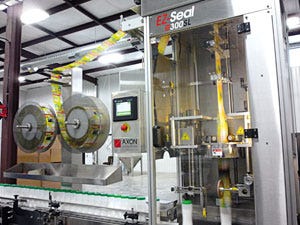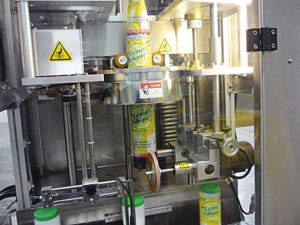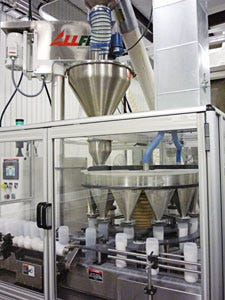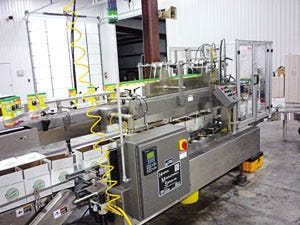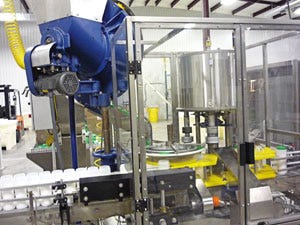|
Film is pulled through the labeler unwind system which ensures that the film-delivery system located inside the machine has a constant supply of film that is not under |
Envirocon Technologies, Inc. was founded in 1994 in Midland, TX to produce Lemi Shine®, a dishwasher-detergent additive that works with conventional detergents to remove tough hard-water spots and film from glassware and even dishwashers. The product had always been packaged in a straight-sided bottle with a screw cap, but "the package just never stood out on the shelf, even though the product has always been a success," says CEO Curtis Eggemeyer. In August 2007, Envirocon introduced a new, ergonomic container for Lemi Shine that includes a dispensing closure with a flip-top cap that makes dispensing the product easier, a curved bottle that makes one-handed use possible and a total-coverage shrink-sleeve label. "This new container with the spectacular label really gets noticed," says Eggemeyer.
|
After the film is cut, the label is pushed down onto the container by the film-application rollers located at the base of the mandrel. |
The HDPE bottle is supplied by CKS Packaging, Inc.(www.ckspackaging.com) and the dispensing closures are supplied by Phoenix Closures(www.phoenixclosures.com). Berlin Packaging(www.berlinpack.com) is the distributor for the both bottles and closures. The labels, which were designed by Fresh Ink(www.haveamission.com), are supplied by Seal-It, A Div. ofPrintpack, Inc.(www.printpack.com), and are made from maximum-shrink PVC and are nine-color rotogravure-printed. "Achieving the bright yellow color of the label was a challenge," says Eggemeyer. "Printpack worked with our art department to create a proof that met our requirements."
Shrink-sleeve labeler
Envirocon built a new plant at its headquarters in Midland and installed a new packaging line to run the new container. With shelf presence and bottle appearance being the essential purpose of the new package design, the key equipment component of the line is a Model 300SL EZ-Seal shrink-sleeve labeler from Axon Corp.(www.axoncorp.com). "This was an ideal machine for us," says Eggemeyer. "It's a very simple machine to operate and has a small footprint, so it fits into our operation. The machine works flawlessly, and Axon's service people have been outstanding. They helped us start it up, and other than that, it runs perfectly." A feedscrew meters the containers into the labeler.
|
An auger meters detergent into 12 funnels that deliver the product into containers traveling on the rotary turntable. |
The film is pulled up by idler rollers mounted above the film rolls that provide a consistent film path between the two film reels and the film-unwind system. This allows the film path and tension to be identical for both film-roll locations.
The film then travels through the unwind system, which ensures that the film-delivery system located inside the machine has a constant supply of film that is not under tension. This helps to minimize slippage during film feeding and ensures accurate film-cut lengths. The film travels down through a film-dancer system, where it is looped through a film weight on a slide. As the machine advances the film, the weight is pulled upward, triggering a sensor that alerts the unwind to pull more film off of the roll and into the dancer system, causing the weight to drop. When the weight drops below the sensor, the unwind stops feeding film.
Next, the film travels into the sleeve—application chamber, where it passes through a series of guide rollers and is then pulled over the mandrel that opens the tubular film. In this operation, two stepper-driven rollers work in conjunction with the print-registration system to ensure that the correct length of film is advanced. The print-registration, which utilizes a fiberoptic system from Keyence Corp. of America(www.keyence.com), is located at the top of the film mandrel and includes both vertical and horizontal adjustments. When a detection photoeye senses the container, multiple blades located around the mandrel cut the film, which is then advanced down the mandrel by the following label. Finally, the cut sleeve is pushed down
|
onto the container by the film-application rollers located at the base of the mandrel.
Rotary dry-product filler
The bottling operation starts with an Omni-Line 350 bottle unscrambler/orienter from Pace Packaging Corp.(www.pacepkg.com). The bottles are dumped into the hopper, which orients them so they all have the bottom ends leading as they discharge into a standup position on a lower conveyor that transports them to the filler.
The dry detergent is delivered to the filler in a 1,200-lb plastic bin, and a bulk dumper from Meyer Machine Co.(www.meyer-industries.com) lifts the bin and dumps the product into the floor hopper of a flexible inclined screw conveyor from Flexicon Corp.(www.flexicon.com). The product flows out of the floor hopper into the screw conveyor, and the loosely fitting, rotating flexible screw within the tube transports the product up to the top, where it discharges through a chute into the filler hopper. A level control in the hopper controls infeed to maintain a consistent level.
|
When the correct number of bottles have accumulated, the empty case is lifted and a plate retracts to allow the bottles to drop into the case. |
Twelve funnels are mounted around the top of the rotating filler turret and the dry powder discharges from the hopper into an auger that discharges the powder into the funnels as they pass beneath it. Bottles from the unscrambler are conveyed to the 12-head rotary filler from All- Fill, Inc.(www.all-fill.com). A sensor monitors containers on the conveyor to the filler, and shuts the machine off if no containers are present. As the containers enter the filler, they engage sealing pads on the bottoms of the funnels that create a tight seal for dust control. The funnels travel synchronously above the containers as the turret rotates.
The proper weight of product in a container is achieved by coordinating the respective rotating speeds of the turret and the auger. The conveyor continues past the front of the filler and picks up the filled cans as they discharge.
All-Fill installed a dust shroud connected to a vacuum source at the top of the rotating turret to remove dust. "The All-Fill filler is a phenomenal machine," says Eggemeyer. "It's easy to operate and we've had absolutely no problems. It's very precise. We maintain a variance of less than 0.1 oz."
Capping system
After filling, the bottles travel to the capping operation. The first step is a glue applicator from Dillin Capping Systems(capperwww.dillin.net) that applies a film of cold adhesive to the top surface of the container finishes so that a sheet liner in the cap will adhere to the finish. Next the bottles travel through a rebuilt capping system from Change Parts, Inc.(www.changeparts.com). This starts with a vertical rotating cap prefeeder that orients the caps with the tops all facing in the same direction. The caps travel down a chute and are picked from the bottom of the chute by a rotating four-station table. The table carries the caps to a four-head rotary capper, where the heads pick up the caps and apply them to the containers traveling on a table beneath them.
Bottles enter and leave the capper through starwheels. E-Pak Machinery(www.epakmachinery.com) sourced all of the packaging components and integrated the packaging operation. It also supplied a floor hopper and elevator to deliver caps to the prefeeder.
Case packing
|
Caps are sorted in a vertical rotary unit and then travel down a chute to a four-station transfer table that transports them to the four-head rotary capper. |
The capped containers travel through the labeling operation described previously and then convey to a case-packing operation. Cases are erected by a Model XRT450 case erector from Trinamics, Inc.(www.trinamics.com). The erectors can be supplied with either a hot-melt glue system from Nordson Corp.(www.nordsen.com) or a pressure-sensitive tape sealing system from Dekka Indusries, Inc.(www.dekkaindustries.com). The unit at Envirocon uses the tape-sealing system. Other components include pneumatic valves, vacuum generators and cylinders from Festo Corp.(www.festo.com/us) and Allen Bradley MicroLogix® PLC controls from Rockwell Corp(www.rockwell.com).
The containers are then packed by a Model 300E case packer from Hamrick Mfg. & Services, Inc.(www.hamrickmfg.com). Containers enter the machine single file and then converge into two or three lanes depending on the coordinated pack size. A pneumatic agitator assembly on the infeed prevents lane jams and helps attain consistent lane accumulations. Empty cases enter on a lower-level conveyor. When the correct number of bottles has accumulated, the empty case is lifted and a plate retracts to allow the bottles to drop into the case. The filled cases exit on a powered conveyor. "We surveyed the market and selected the Hamrick case packer, and we've been very pleased," says Eggemeyer. "I've used this term several times, and I'll use it again. The Hamrick machine is very simplistic and easy to use. That was one of the things we were looking for when we put this line together. We're 300 miles from the nearest metro area, so we wanted equipment that would be easy for our people to operate and maintain without requiring service calls, and that's what we have."
The cases travel to a Bel 252 top taper from Wexxar Packaging, Inc., (www.wexxar.com) that is equipped with Dekka tape heads. The machine also features BEL's Snap Folder safe-flap folding technology, which promotes the protection of personnel by eliminating the traditional flapkicker that can cause serious injury. The container conveyors throughout the packaging line are supplied by Accutek Packaging Equipment Co., Inc.(www.accutekpackaging.com). All of the equipment features controls from Rockwell Automation.
More information is available: |
Axon Corp. 919/772-8383. www.axoncorp.com. |
Accutek Packaging Equipment Co., Inc., 760/734-4177. www.accutekpackaging.com. |
All- Fill, Inc., 610/524-7350. www.all-fill.com. |
Berlin Packaging, 800/723-7456. www.berlinpack.com. |
Change Parts, Inc., 231/845-5107. www.changeparts.com. |
CKS Packaging, Inc. 404/691-8900. www.ckspackaging.com. |
Dekka Industries, Inc., 604/278-7881. www.dekkaindustries.com. |
Dillin Capping Systems, 419-666-6789. www.dillin.net. |
E-Pak Machinery, 219/393-5541. www.epakmachinery.com. |
Festo Corp., 631/435-0800. www.festo.com/us. |
Flexicon Corp., 610-814-2400. www.flexicon.com. |
Fresh Ink, 850/215-2321. www.haveamission.com. |
Hamrick Mfg. & Services, Inc., 800/321-9590. www.hamrickmfg.com. |
Keyence Corp. of America, 201/930-0100. www.keyence.com. |
Meyer Machine Co., 210/736-1811. www.meyer-industries.com. |
Nordson Corp., 770/497-3700. www.nordson.com. |
Pace Packaging Corp., 973/227-1040. www.pacepkg.com. |
Phoenix Closures, 630/420/4750. www.phoenixclosures.com. |
Rockwell Automation, 414/382-2000. www.rockwellautomation.com. |
Seal-It, A Div. ofPrintpack, Inc., 404/460-7000. www.printpack.com. |
Trinamics, Inc., 519/942-2442. www.trinamics.com. |
Wexxar Packaging, Inc., 604/930-9300. www.wexxar.com. |
About the Author(s)
You May Also Like
